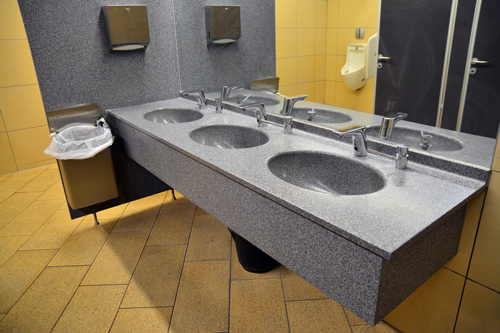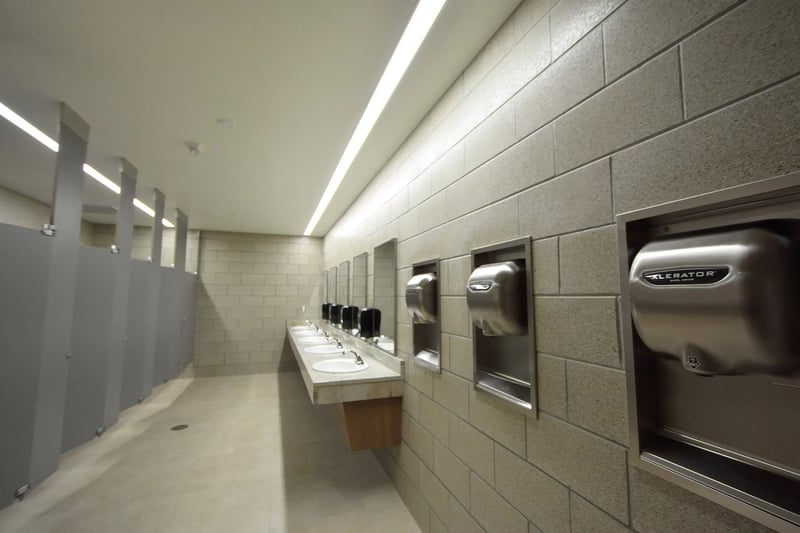

Facilities such as schools, hotels, retail stores, office buildings, and hospitals represent roughly 17% of publicly supplied water use.
Restrooms account for the highest percentage of water use in all of these buildings, with heating and cooling and landscaping as the next two highest uses.
So how can you reduce the amount of water that your building uses? Here are 7 ways that MEP engineering services on mechanical and plumbing system designs can lower your water bills and your water footprint.
There are a number of products that can save substantial amounts of water when compared to conventional fixtures. Utilizing flush valves for toilets and urinals and/or low-flow versions of each, as well as installing low-flow faucets, or aerators can significantly reduce water use.
A one-gallon-per-minute (gpm) aerator installed on a faucet can save more than 50% of water used when compared to standard 2.2 gpm faucets. In addition, these low-flow aerators can maintain the same amount of pressure as a standard aerator.
The federal standard for toilet water use is 1.6 gallons per flush, while a low-flow model can use about 20% less water at 1.28 gallons per flush. Dual flush models that utilize 1.6 gallons for solid waste and 0.8 gallons for liquid waste offer water savings of roughly 30%.
Although the installation of low-flow fixtures represents a significant initial investment, these costs can often be recovered within the first year.
Touch-free faucets keep water running only when they sense a person’s hands underneath. While it could be difficult to quantify how much water this actually saves, these faucets can prevent a user from leaving a faucet running overnight or during a long weekend, and thus stop a significant amount of water from running down the drain.
Over the past couple of years, codes and standards across industries have mandated the insulation of hot water pipes. However, in many existing commercial buildings, domestic hot and hot water return piping is either uninsulated or not insulated properly.
Properly insulating pipes ensures that hot water will be ready to flow when a user turns on a faucet. Oftentimes, a user will wait for water to heat up before washing hands or taking a shower. According to the U.S. Department of Energy, insulated pipes can deliver water at temperatures 2-4 degrees (F) higher than uninsulated pipe. Less time waiting for water to heat up means more water saved.
Rain sensors are designed to identify when precipitation is present and prevent sprinklers and other irrigation systems from running when watering is unnecessary. After rain or precipitation occurs, the sensors will automatically reset and allow the system to return to its regular schedule.
Certain types of sprinkler heads can also apply water more evenly than others, and drip systems can be even more efficient than conventional sprinklers because they deliver low volumes of water directly to the plant’s roots. Drip systems minimize losses to wind, runoff or evaporation, and can use up to 20-50% less water than traditional sprinkler systems.
There are a number of ways to alter your plant landscapes in order to minimize your water use outdoors:
Cooling towers account for the largest percentage of water consumption in industrial operations. Cooling towers remove heat from a buildings air conditioning system by evaporating condenser water. Since all cooling towers are constantly losing water through evaporation, drift and bleed-off, they can make up a large portion of a buildings water usage.
You can boost the efficiency of your buildings cooling tower a number of ways:
Cooling towers can pull water from a number of alternative water sources that won’t require them to be supplied by local water authorities.
A greywater system can provide non-potable gently-used water from bathroom sinks, showers, tubs, and washing machines. Rainwater or stormwater can be collected in simple above or underground tanks. A facility with a 30x30 square foot roof can collect 558 gallons of water for every inch of rain. Condensate from air conditioning or refrigeration systems can also be used.
Cleaning water and bleed water can also be utilized for toilet flushing, landscape irrigation, maintenance cleaning, and filter backwash uses.
Contact us to learn more about how Peter Basso Associates can use its decades of commissioning, engineering and LEED® expertise to help improve your building's operations and performance.
These Stories on Plumbing
Comments (2)